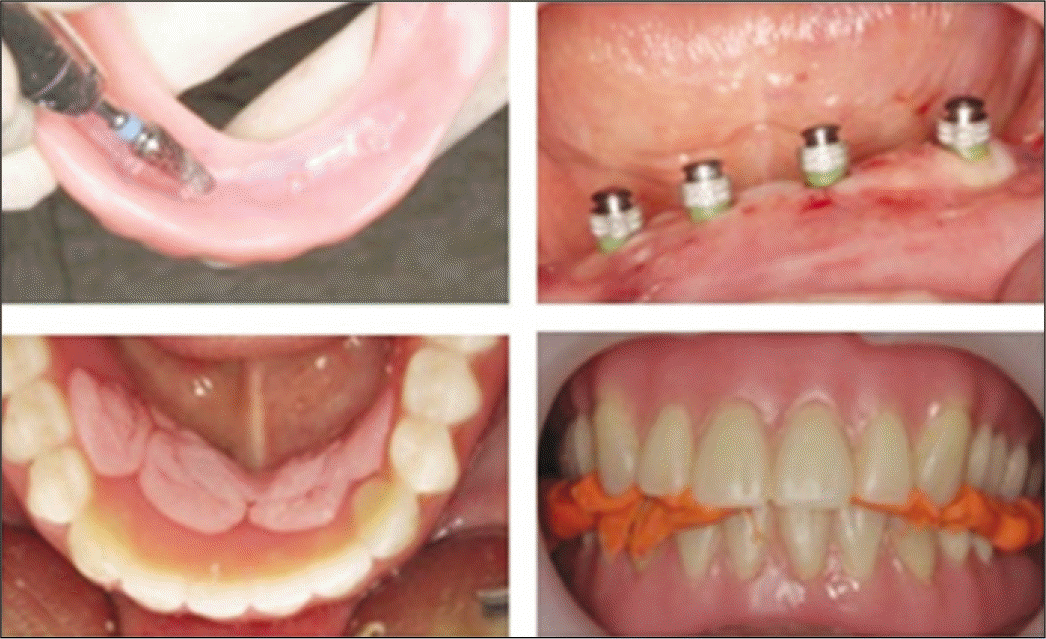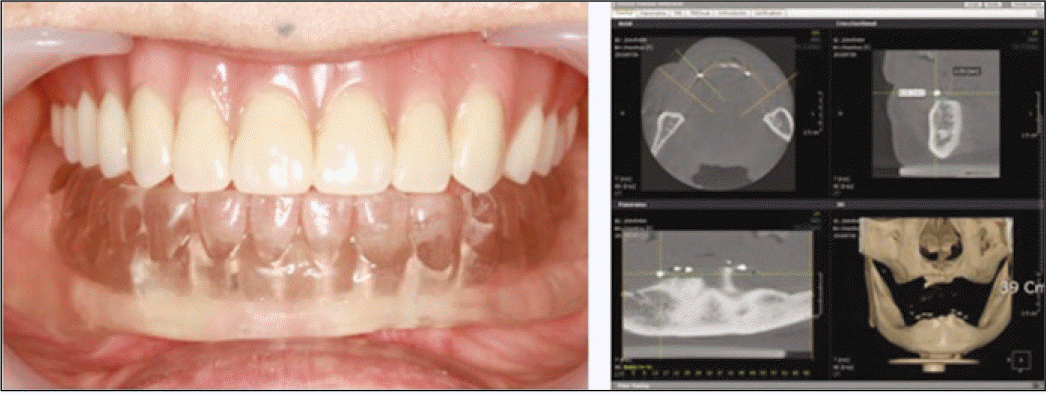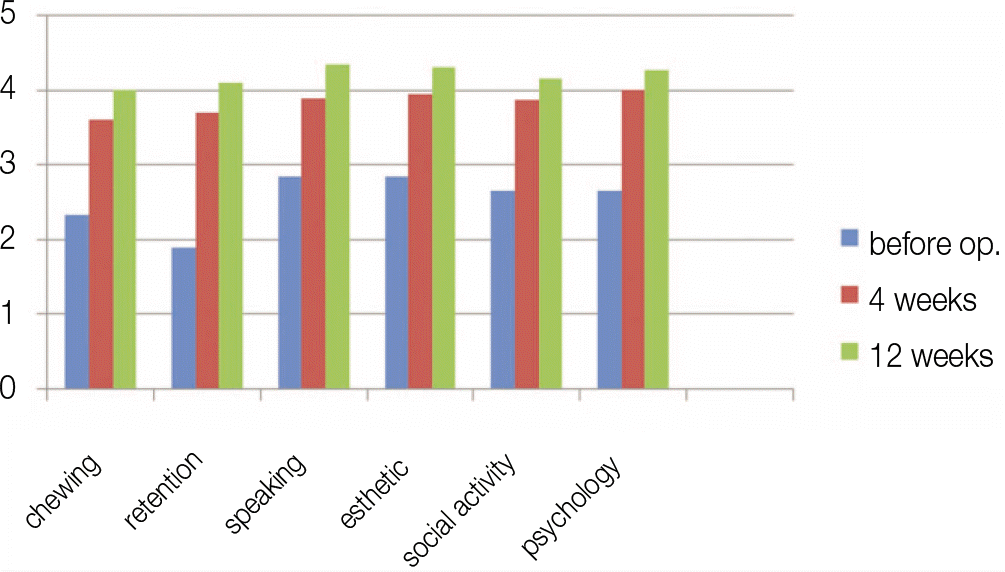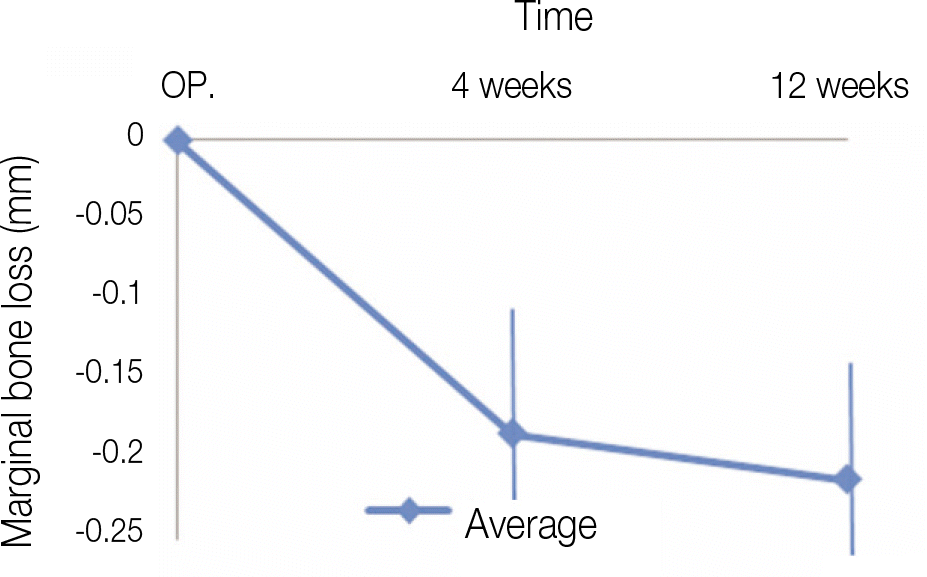Abstract
Purpose
In cases when implant supported overdenture is made by using standard size implant, additional procedure such as bone surgery and bone grafting can be required. And it gives burden to doctor and patient in terms of cost. Therefore, it is necessary to find the implant therapy for the edentulous patients in making denture with accordable cost and simple procedure.
Materials and methods
Edentulous patients with upper and lower dentures participated in this study. Before the operation, survey about patient's satisfaction to the existing dentures was carried out. Surgical procedures included four small diameter implants installation anterior area and immediate loading. One and three month after the procedure, the same survey about patient's satisfaction was carried out, and radiography was taken.
Results
We are doing research to the nine patients. Survival rate is 97.2 percent. The comparison of patient's satisfaction before and after surgery is performed based on oral health impact profile 49. We analyze mainly with masticatory discomfort, retention, aesthetics, social problem, psychological discomfort problems. As a result, satisfaction level is increased at all factors. Retention is the most increased satisfactory factor followed by mastication difficulty, pronunciation, psychological discomfort, social discomfort, aesthetics in order. Marginal bone loss is 0.21 mm at 12 weeks after implant placement.
Go to : 
REFERENCES
1.Redford M., Drury TF., Kingman A., Brown LJ. Denture use and the technical quality of dental prostheses among persons 18-74 years of age: United States, 1988-1991. J Dent Res. 1996. 75:714–25.

2.Tarbet WJ., Boone M., Schmidt NF. Effect of a denture adhesive on complete denture dislodgement during mastication. J Prosthet Dent. 1980. 44:374–8.

3.Raghoebar GM., Meijer HJ., Stegenga B., van' t Hof MA., van Oort RP., Vissink A. Effectiveness of three treatment modalities for the edentulous mandible. A five-year randomized clinical trial. Clin Oral Implants Res. 2000. 11:195–201.
4.Banton B., Henry MD. Overdenture retention and stabilization with ball-and-socket attachments: principles and technique. J Dent Technol. 1997. 14:14–20.
5.Flanagan D. Implant-supported fixed prosthetic treatment using very small-diameter implants: a case report. J Oral Implantol. 2006. 32:34–7.

6.Carlsson GE., Lindquist LW. Ten-year longitudinal study of masticatory function in edentulous patients treated with fixed complete dentures on osseointegrated implants. Int J Prosthodont. 1994. 7:448–53.
7.Sendax VI. Mini-implants as adjuncts for transitional prostheses. Dent Implantol Update. 1996. 7:12–5.
9.Horiuchi K., Uchida H., Yamamoto K., Sugimura M. Immediate loading of Bra®nemark system implants following placement in edentulous patients: a clinical report. Int J Oral Maxillofac Implants. 2000. 15:824–30.
10.Porter JM. Same-day restoration of mandibular single-stage implants. J Indiana Dent Assoc. 2002. 81:22–5.
11.Vigolo P., Givani A., Majzoub Z., Cordioli G. Clinical evaluation of small-diameter implants in single-tooth and multiple-implant restorations: a 7-year retrospective study. Int J Oral Maxillofac Implants. 2004. 19:703–9.
13.Choi R. Incorporating mini-implants within the general dental practice. Pract Proced Aesthet Dent. 2007. 19:1–5.
14.Balkin BE., Steflik DE., Naval F. Mini-dental implant insertion with the auto-advance technique for ongoing applications. J Oral Implantol. 2001. 27:32–7.

15.English CE., Bohle GC. Diagnostic, procedural and clinical issues with Sendax mini dental implant. Compend Contin Educ Dent. 2003. 24:3–25.
16.Lekholm U, Zarb GA: Patient selection and preparation. In: Braemark PI, Zarb GA, Albrektsson T (eds): Tissue-integrated prostheses: Osseointegration in clinical dentistry. Quintessence;Chicago: 1985. p. 199–209.
17.Slade GD., Spencer AJ. Development and evaluation of the Oral Health Impact Profile. Community Dent Health. 1994. 11:3–11.
18.Slade GD. Derivation and validation of a short-form oral health impact profile. Community Dent Oral Epidemiol. 1997. 25:284–90.

19.Griffitts TM., Collins CP., Collins PC. Mini dental implants: an adjunct for retention, stability, and comfort for the edentulous patient. Oral Surg Oral Med Oral Pathol Oral Radiol Endod. 2005. 100:e81–e84.

20.Shatkin TE., Shatkin S., Oppenheimer BD., Oppenheimer AJ. Mini dental implants for long-term fixed and removable prosthetics: a retrospective analysis of 2514 implants placed over a five-year period. Compend Contin Educ Dent. 2007. 28:92–9.
21.Szmukler-Moncler S., Piattelli A., Favero GA., Dubruille JH. Considerations preliminary to the application of early and immediate loading protocols in dental implantology. Clin Oral Implants Res. 2000. 11:12–25.

22.Dilek O., Tezulas E., Dincel M. Required minimum primary stability and torque values for immediate loading of mini dental implants: an experimental study in nonviable bovine femoral bone. Oral Surg Oral Med Oral Pathol Oral Radiol Endod. 2008. 105:e20–e27.

23.Boerrigter EM., Stegenga B., Raghoebar GM., Boering G. Patient satisfaction and chewing ability with implant-retained mandibular overdentures: a comparison with new complete dentures with or without preprosthetic surgery. J Oral Maxillofac Surg. 1995. 53:1167–73.

24.Jofre′ J., Hamada T., Nishimura M., Klattenhoff C. The effect of maximum bite force on marginal bone loss of mini-implants supporting a mandibular overdenture: a randomized controlled trial. Clin Oral Implants Res. 2010. 21:243–9.
25.Cox JF., Zarb GA. The longitudinal clinical efficacy of osseointegrated dental implants: a 3-year report. Int J Oral Maxillofac Implants. 1987. 2:91–100.
26.Adell R., Lekholm U., Rockler B., Bra�nemark PI. A 15-year study of osseointegrated implants in the treatment of the edentulous jaw. Int J Oral Surg. 1981. 10:387–416.

27.Cochran DL., Hermann JS., Schenk RK., Higginbottom FL., Buser D. Biologic width around titanium implants. A histometric analysis of the implanto-gingival junction around unloaded and loaded nonsubmerged implants in the canine mandible. J Periodontol. 1997. 68:186–98.

28.Kim JW., Kim HS., Baik J., Kwon KR. Novel treatment modality of implant-retained overdenture for immediate function in completely edentulous patients. J Korean Acad Prosthodont. 2007. 45:34–47.
Go to : 
 | Fig. 2.Drilling with pilot drill and implant placement. Implant was placed by using finger driver and thumb wrench after treated for drilling 1/3 of 1/2 length of implant by pilot drill which is 1.1 mm in diameter. Implant placement was completed by using torque wrench for tightening implant in the force of 35 N/cm. |
 | Fig. 3.Prosthetic procedure. Relief the spots smeared by marking pen in the impression area of denture, and install the MH-2 after blocking out of the implant. Auto-polymerization acrylic resin was filled in the area of relief and MH-2 was attached to denture by using bite records acquired before surgery. |
Table 1.
Demographic data and clinical features of patients
| Patients | Gender | Age (year) | Denture wearing time (months) |
|---|---|---|---|
| No 1. | M | 68 | 1 |
| No 2. | M | 62 | 1 |
| No 3. | M | 77 | 2 |
| No 4. | M | 67 | 2 |
| No 5. | M | 73 | 6 |
| No 6. | F | 61 | 5 |
| No 7. | F | 66 | 9 |
| No 8. | F | 69 | 11 |
| No 9. | F | 77 | 72 |
Table 2.
Classification of questions
Table 3.
Summary of questionnaire results
Table 4.
Summary of questionnaire results about insufficient retention
| Questions | Before op. (SD) | 4 weeks (SD) | 12 weeks (SD) |
|---|---|---|---|
| Fitting | 2.00 (1.07) | 3.63 (0.52) | 3.83 (0.41) |
| Frequent dropping of denture | 1.75 (0.71) | 3.75 (0.46) | 4.33 (0.52) |
Table 5.
Summary of questionnaire results about masticatory difficulty
Table 6.
Summary of questionnaire results about psychological problems
Table 7.
Summary of questionnaire results about speaking difficulty
Table 8.
Summary of questionnaire results about discomfort during social activity
| Questions | Before op. (SD) | 4 weeks (SD) | 12 weeks (SD) |
|---|---|---|---|
| Economical | 2.21 | 3.46 | 4.06 |
| Personal relations | 2.78 | 4.05 | 4.10 |
| Self confidence | 3.00 | 4.00 | 4.42 |
Table 9.
Summary of questionnaire results about esthetic problem
Table 10.
Mean marginal bone loss according to the initial bone level (Unit: mm




 PDF
PDF ePub
ePub Citation
Citation Print
Print





 XML Download
XML Download